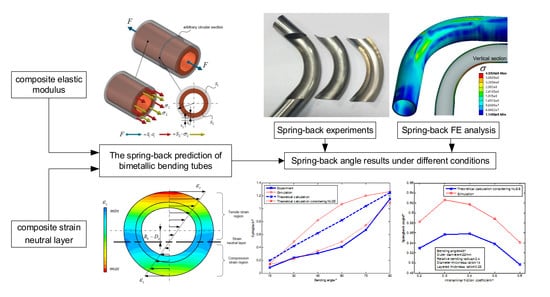Spring-Back Prediction of the Bi-Layered Metallic Tube under CNC Bending Considering Neutral Layer Shifting Extraction
Abstract
1. Introduction
2. Theoretical Model of the Bimetallic Tube Bending Spring-Back
2.1. Principle of the Bimetallic Tube Spring-Back
2.2. Uploading Moment of the Bimetallic Tube
2.3. NLSE Method
3. Regression Analysis of Neutral Layer Shifting
3.1. Experimental Design
3.2. Regression Model and Solution
4. Flow of Bimetallic Tubes’ Spring-Back Prediction Based on NLSE
5. Spring-Back Prediction and Verification
5.1. FE Simulation
5.2. CNC Bending Experiments of the Bimetallic Tube
6. Results and Comparison
6.1. Neutral Layer Shifting
6.2. Spring-Back
7. Conclusions
- Under the bending condition within 90°, the spring-back angle of the bimetallic tube is increased with the bending angle. This trend is the same as single-layered tubes. It indicates that the increase of plastic deformation degree with the increasing of bending angle does not matter for the spring-back of bimetallic tubes. The spring-back angle does not decrease with the increasing of the plastic deformation degree, and the bending angle is still the main effective factor of bimetallic tubes’ spring-back. If the neutral layer shifting is neglected, the theoretical spring-back angles of bimetallic tubes will increase linearly with the bending angle. The theoretical spring-back angles considering the NLSE model are smaller and closer to experimental results.
- The section strain of bimetallic tubes is continuous at the contact between layers. Therefore, the neutral layer shifting of bimetallic tubes can be described by the position of the coincident strain neutral layer. While the outer material is stainless steel and the inner material is carbon steel, the greatest effective factor of the bimetallic tubes’ neutral layer shifting is the layered thickness ratio. The effective secondary factor is the interlaminar friction coefficient. Generally, the larger the layered thickness ratio and the smaller the interlaminar friction coefficient, the larger the neutral layer shifting.
- When the interlaminar friction coefficient is below 0.3, the spring-back angle of bimetallic tube increase with the increase of the interlaminar friction coefficient. For those normal mechanical bonding bimetallic tubes, their interlaminar friction coefficients are less than 0.3 generally. In order to reduce the spring-back and improve the forming accuracy, suitable materials should be selected, and appropriate surface treatments can be done on the interface to reduce the friction coefficient.
Author Contributions
Funding
Conflicts of Interest
References
- Yang, H.; Li, H.; Zhang, Z.; Zhan, M.; Liu, J.; Li, G. Advances and trends on tube bending forming technologies. Chin. J. Aeronaut. 2012, 25, 1–12. [Google Scholar] [CrossRef]
- Li, H.; Yang, H.; Zhang, Z.; Li, G.; Liu, N.; Welo, T. Multiple instability-constrained tube bending limits. J. Mater. Process. Technol. 2014, 214, 445–455. [Google Scholar] [CrossRef]
- Li, S.J.; Zhou, C.Y.; Li, J.; Pan, X.; He, X. Effect of bend angle on plastic limit loads of pipe bends under different load conditions. Int. J. Mech. Sci. 2017, 572–585. [Google Scholar] [CrossRef]
- Lapovok, R.; Ng, H.P.; Tomus, D.; Estrin, Y. Bimetallic copper–aluminium tube by severe plastic deformation. Scr. Mater. 2012, 66, 1081–1084. [Google Scholar] [CrossRef]
- Salehi, J.; Rezaeian, A.; Toroghinejad, M.R. Fabrication and characterization of a bimetallic Al/Cu tube using the tube sinking process. Int. J. Adv. Manuf. Technol. 2018, 96, 153–159. [Google Scholar] [CrossRef]
- Ganesh, P.; Kaul, R.; Mishra, S.; Bhargava, P.; Paul, C.; Singh, C.P.; Tiwari, P.; Oak, S.M.; Prasad, R.C. Laser rapid manufacturing of bi-metallic tube with Stellite-21 and austenitic stainless steel. T Indian I Metals 2009, 62, 169–174. [Google Scholar] [CrossRef]
- Chen, W.C.; Petersen, C. Corrosion performance of welded CRA-lined pipes for flowlines. SPE Prod. Eng. 1992, 7, 375–378. [Google Scholar] [CrossRef]
- Scharinger-Urschitz, G.; Walter, H.; Brier, J. Experimental investigation on bimetallic tube compositions for the use in latent heat thermal energy storage units. Energy Convers. Manag. 2016, 125, 368–378. [Google Scholar] [CrossRef]
- Wang, X.; Li, P.; Wang, R. Study on hydro-forming technology of manufacturing bimetallic CRA-lined pipe. Int. J. Mach. Tools Manuf. 2005, 45, 373–378. [Google Scholar] [CrossRef]
- Sun, C.; Liu, J.; Yao, X.; Huang, B.; Li, Y. Research on liquid impact forming technology of double-layered tubes. IOP Conf. Series: Earth Environ. Sci. 2018, 128, 012081. [Google Scholar] [CrossRef]
- Li, W.; Wen, Q.; Yang, X.; Wang, Y.; Gao, D.; Wang, W. Interface microstructure evolution and mechanical properties of Al/Cu bimetallic tubes fabricated by a novel friction-based welding technology. Mater. Des. 2017, 134, 383–393. [Google Scholar] [CrossRef]
- Li, H.; Shi, K.P.; Yang, H.; Tian, Y.L. Significance analysis of processing parameters on wall thinning in tube bending. Adv. Mater. Res. 2012, 622, 437–441. [Google Scholar] [CrossRef]
- Daxin, E.; Liu, Y.; Feng, H. Deformation analysis for the rotary draw bending process of circular tubes: Stress distribution and wall thinning. Steel Res. Int. 2010, 81, 1084–1088. [Google Scholar] [CrossRef]
- Huang, T.; Wang, K.; Zhan, M.; Guo, J.; Chen, X.; Chen, F.; Song, K. Wall thinning characteristics of Ti-3Al-2.5V tube in numerical control bending process. J. Shanghai Jiaotong Univ. 2019, 24, 647–653. [Google Scholar] [CrossRef]
- Liu, N.; Yang, H.; Li, H.; Tao, Z.; Hu, X. An imperfection-based perturbation method for plastic wrinkling prediction in tube bending under multi-die constraints. Int. J. Mech. Sci. 2015, 98, 178–194. [Google Scholar] [CrossRef]
- Yang, L.; Shi, S. Wrinkling analysis for rotary-draw bending of thin-walled tube filled with steel balls. Steel. Res. Int. 2012, 551–554. [Google Scholar]
- Li, H.; Yang, H.; Zhan, M.; Gu, R. A new method to accurately obtain wrinkling limit diagram in NC bending process of thin-walled tube with large diameter under different loading paths. J. Mater. Process. Technol. 2006, 177, 192–196. [Google Scholar] [CrossRef]
- Hasanpour, K.; Barati, M.; Amini, B.; Poursina, M. The effect of anisotropy on wrinkling of tube under rotary draw bending. J. Mech. Sci. Technol. 2013, 27, 783–792. [Google Scholar] [CrossRef]
- Guo, X.; Wei, W.; Xu, Y.; El-Aty, A.A.; Liu, H.; Wang, H.; Luo, X.; Tao, J. Wall thickness distribution of Cu–Al bimetallic tube based on free bending process. Int. J. Mech. Sci. 2019, 150, 12–19. [Google Scholar] [CrossRef]
- Wang, X.; Li, F. Analysis of wall thickness variation in the hydro-bending of a double-layered tube. Int. J. Adv. Manuf. Technol. 2015, 81, 67–72. [Google Scholar] [CrossRef]
- Gavriilidis, I.; Karamanos, S.A. Bending and buckling of internally-pressurized steel lined pipes. Ocean Eng. 2019, 171, 540–553. [Google Scholar] [CrossRef]
- Teng, B.G.; Hu, L.; Liu, G.; Yuan, S.J. Wrinkling behavior of hydro bending of carbon steel/Al-alloy bi-layered tubes. Trans. Nonferrous Met. Soc. China 2012, 22, s560–s565. [Google Scholar] [CrossRef]
- Zhan, M.; Wang, Y.; Yang, H.; Long, H. An analytic model for tube bending springback considering different parameter variations of Ti-alloy tubes. J. Mater. Process. Technol. 2016, 236, 123–137. [Google Scholar] [CrossRef]
- Zhang, Z.; Wu, J.; Guo, R.; Wang, M.; Li, F.; Guo, S.; Wang, Y.; Liu, W. A semi-analytical method for the springback prediction of thick-walled 3D tubes. Mater. Des. 2016, 99, 57–67. [Google Scholar] [CrossRef]
- Wu, J.; Zhang, Z.; Shang, Q.; Li, F.; Wang, Y.; Hui, Y.; Fan, H. A method for investigating the springback behavior of 3D tubes. Int. J. Mech. Sci. 2017, 131, 191–204. [Google Scholar] [CrossRef]
- Li, H.; Yang, H.; Tian, Y.; Li, G.; Wang, Z. Geometry-dependent springback behaviors of thin-walled tube upon cold bending. Sci. China Ser. E: Technol. Sci. 2012, 55, 3469–3482. [Google Scholar] [CrossRef]
- Song, F.; Yang, H.; Li, H.; Zhan, M.; Li, G. Springback prediction of thick-walled high-strength titanium tube bending. Chin. J. Aeronaut. 2013, 26, 1336–1345. [Google Scholar] [CrossRef]
- Dan, W.J.; Zhang, W. Springback angle and plastic elongation prediction of thin-walled tube bending by FEM. Appl. Mech. Mater. 2012, 152, 456–461. [Google Scholar] [CrossRef]
- Shayan, M.; Mohammadpour, M.; Malaki, M.; Ding, H. Springback analysis of two-layer strips in clad cold bimetal bending. Trans. Indian Inst. Met. 2014, 67, 851–859. [Google Scholar] [CrossRef]
- Liu, J.; Xue, W. Unconstrained bending and springback behaviors of aluminum-polymer sandwich sheets. Int. J. Adv. Manuf. Technol. 2016, 91, 1517–1529. [Google Scholar] [CrossRef]
- Liu, J.; Li, L. Springback behaviors of bi-layered non-homogeneous bellows in hydroforming. Int. J. Adv. Manuf. Technol. 2017, 93, 1605–1616. [Google Scholar] [CrossRef]
- Daxin, E.; Guo, X.; Ning, R. Analysis of strain neutral layer displacement in tube-bending process. Chin. J. Mech. Eng. 2009, 45, 307. [Google Scholar] [CrossRef]
- Islam, M.; Olabi, A.G.; Hashmi, M. Feasibility of multi-layered tubular components forming by hydroforming and finite element simulation. J. Mater. Process. Technol. 2006, 174, 394–398. [Google Scholar] [CrossRef]
- Xin, E.D.; Zhou, D. Metal Tube Bending: Theory and Forming Defects Analysis; Beijing University of Technology Press: Beijing, China, 2016. [Google Scholar]

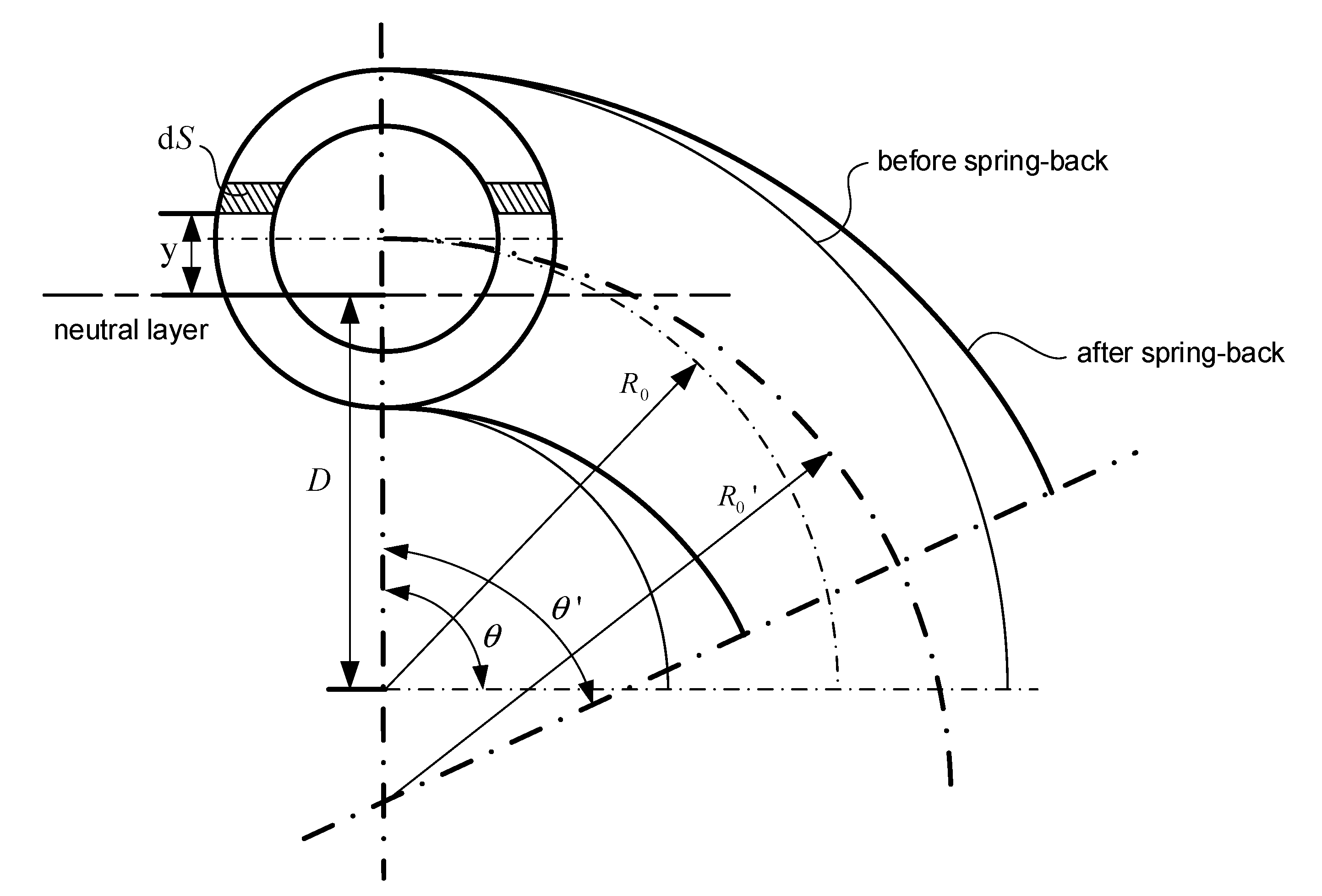
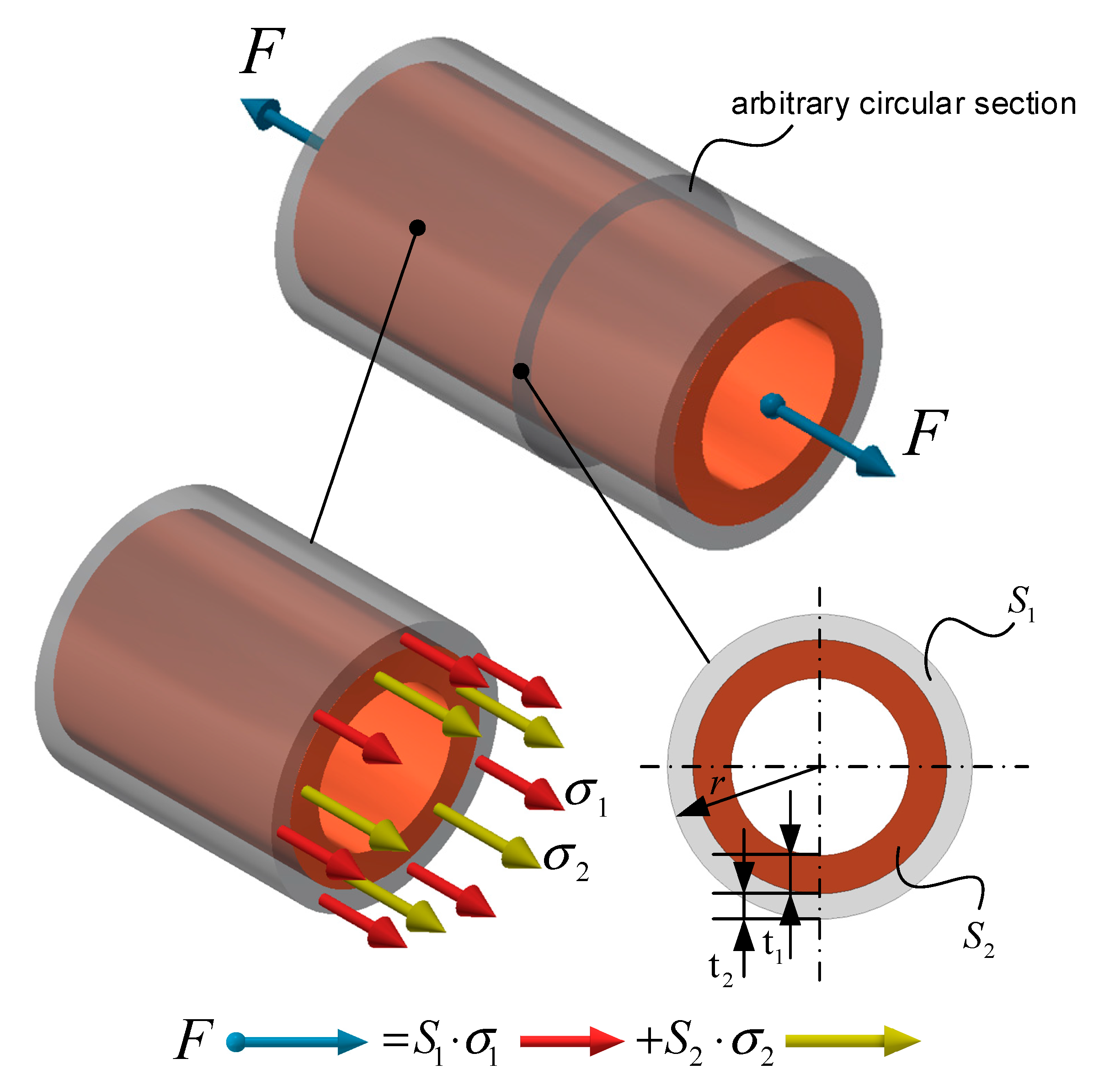
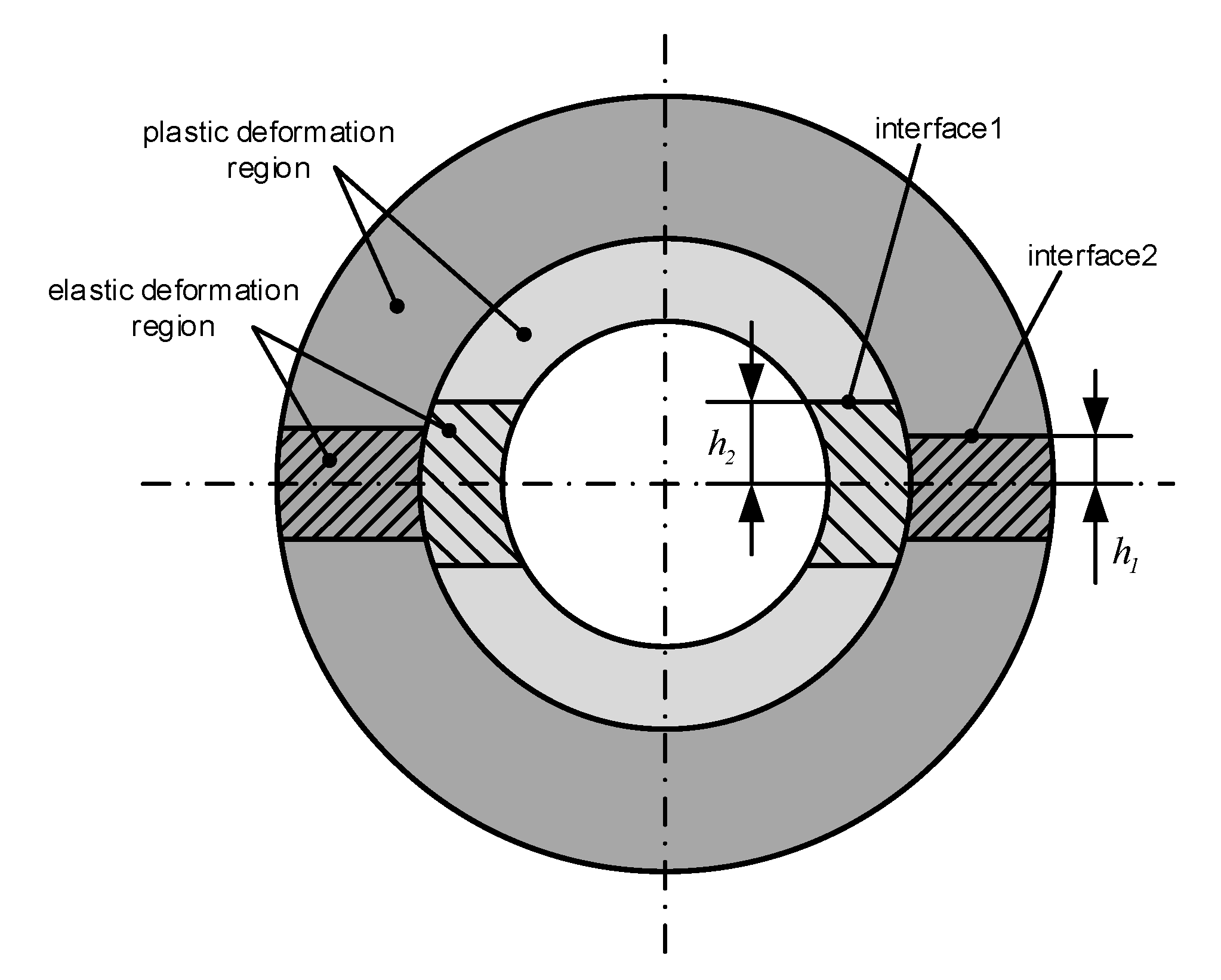
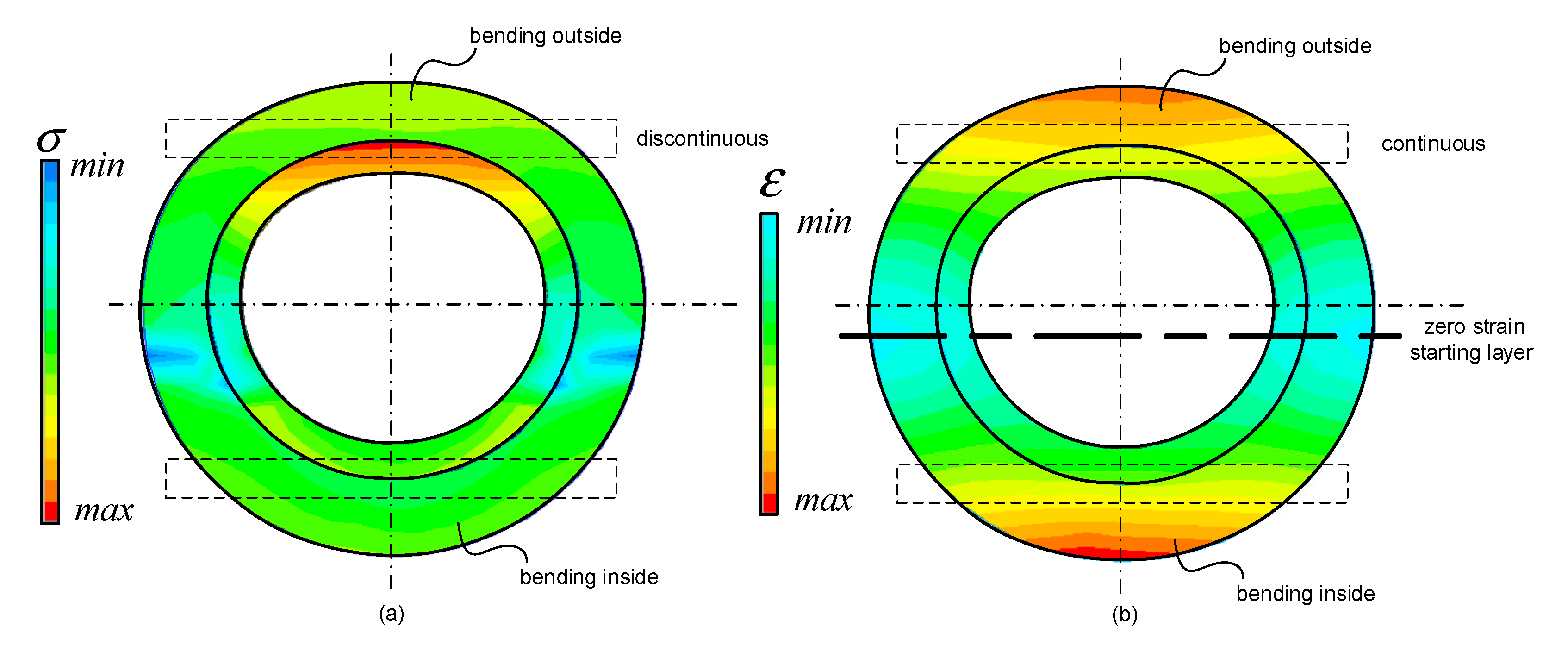
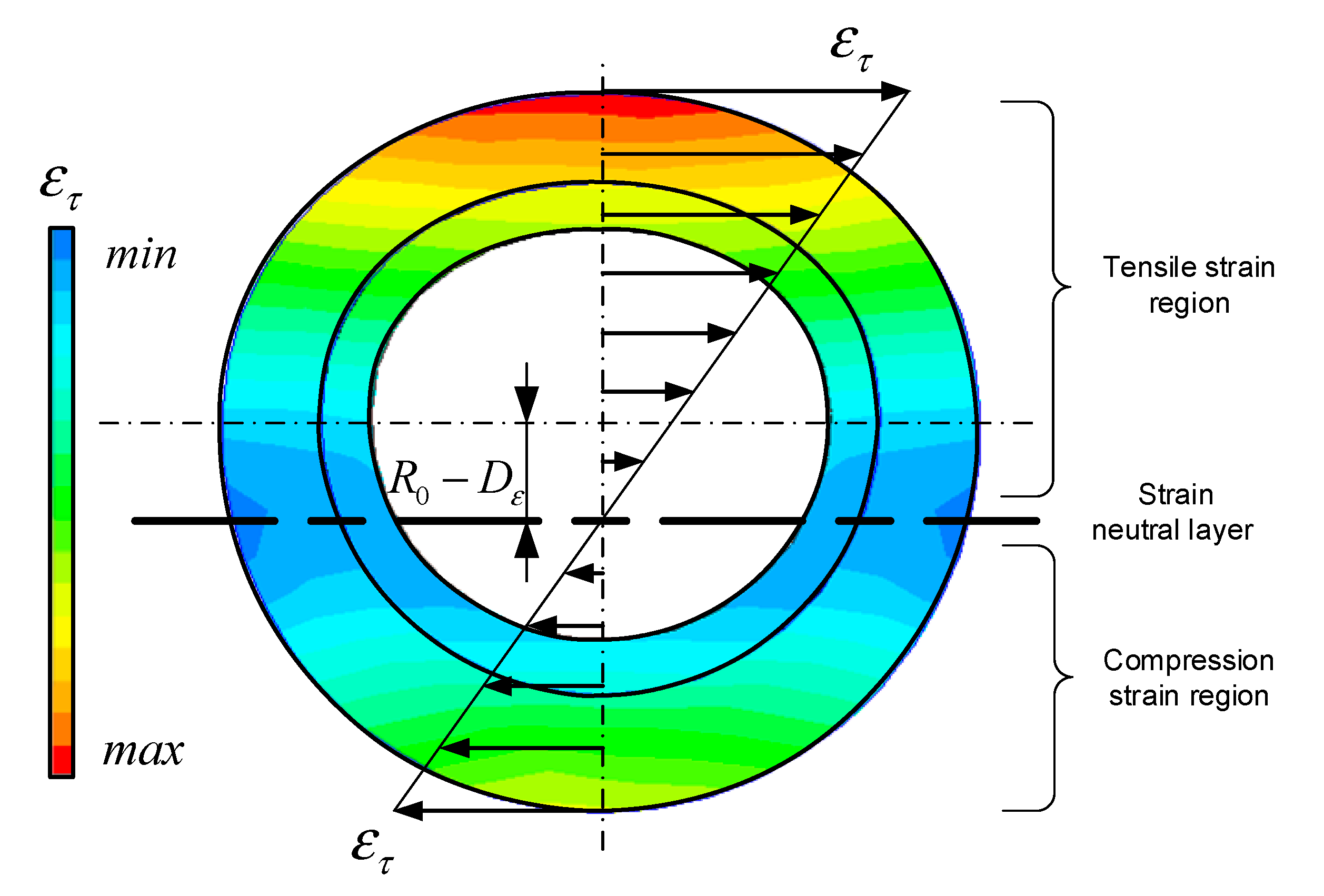

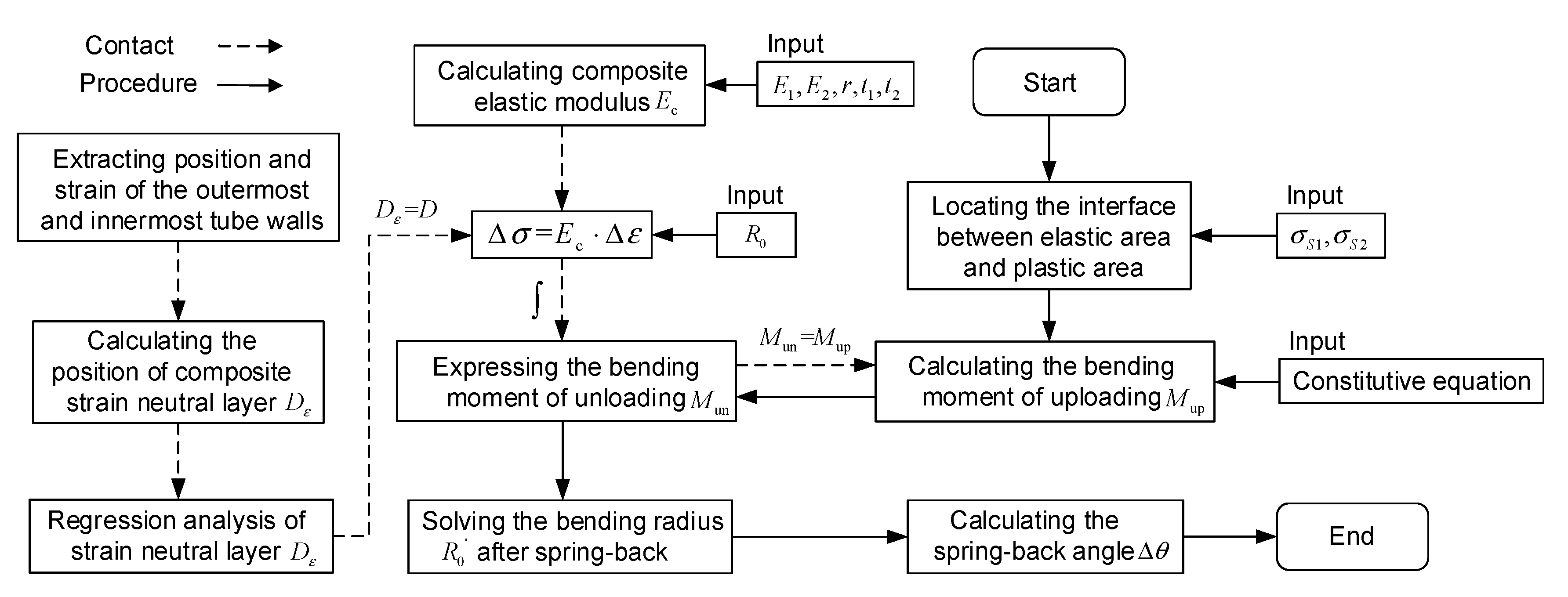
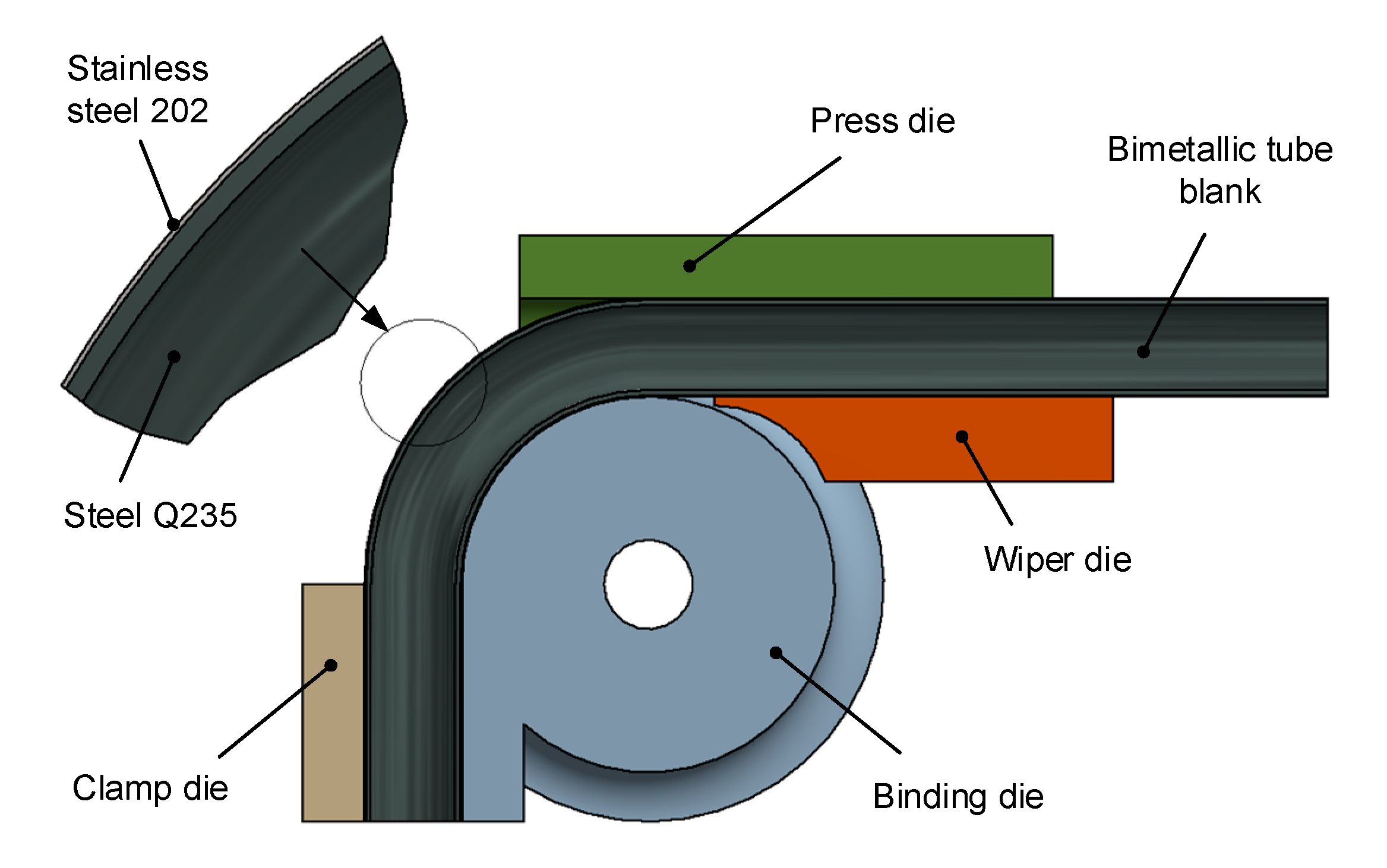
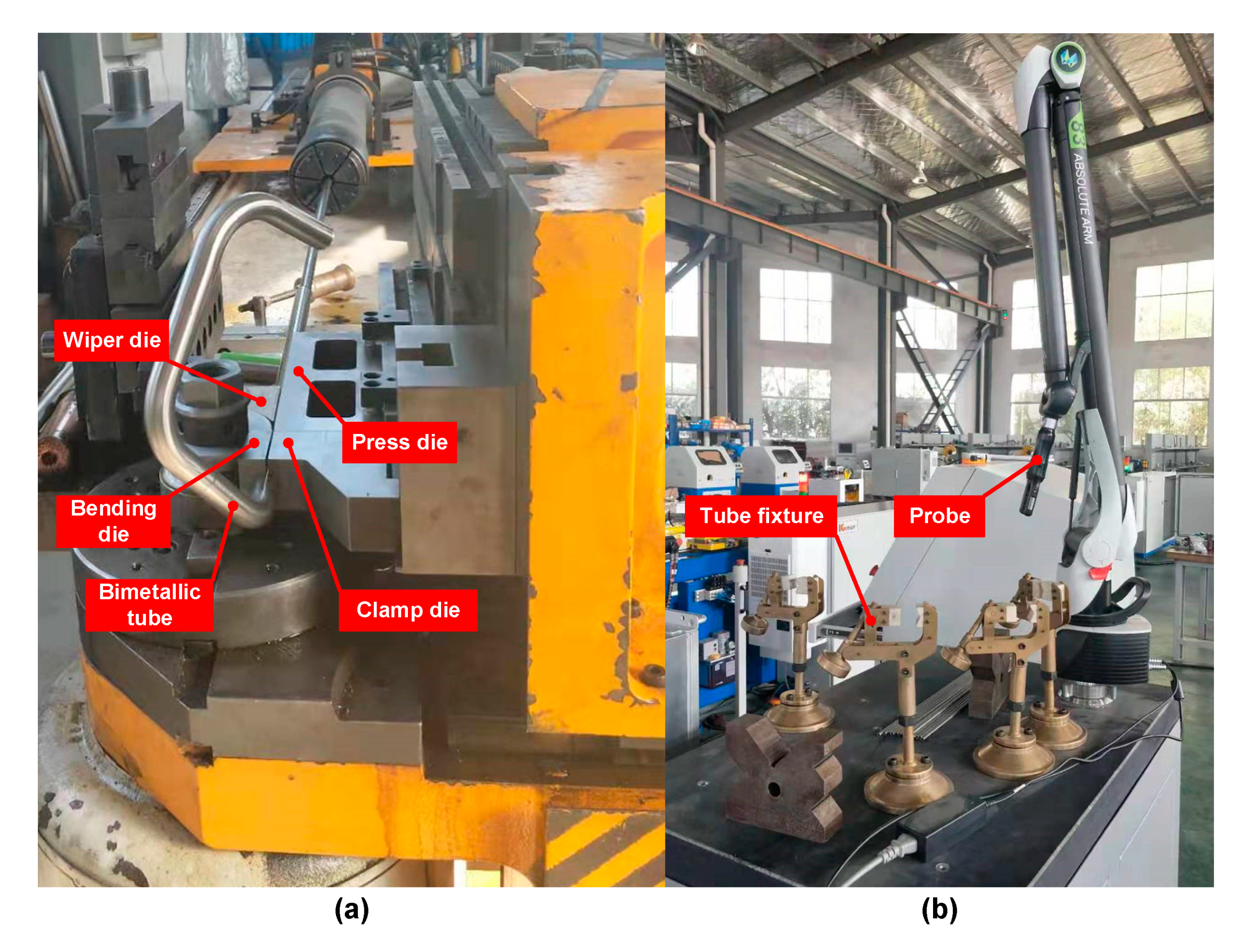

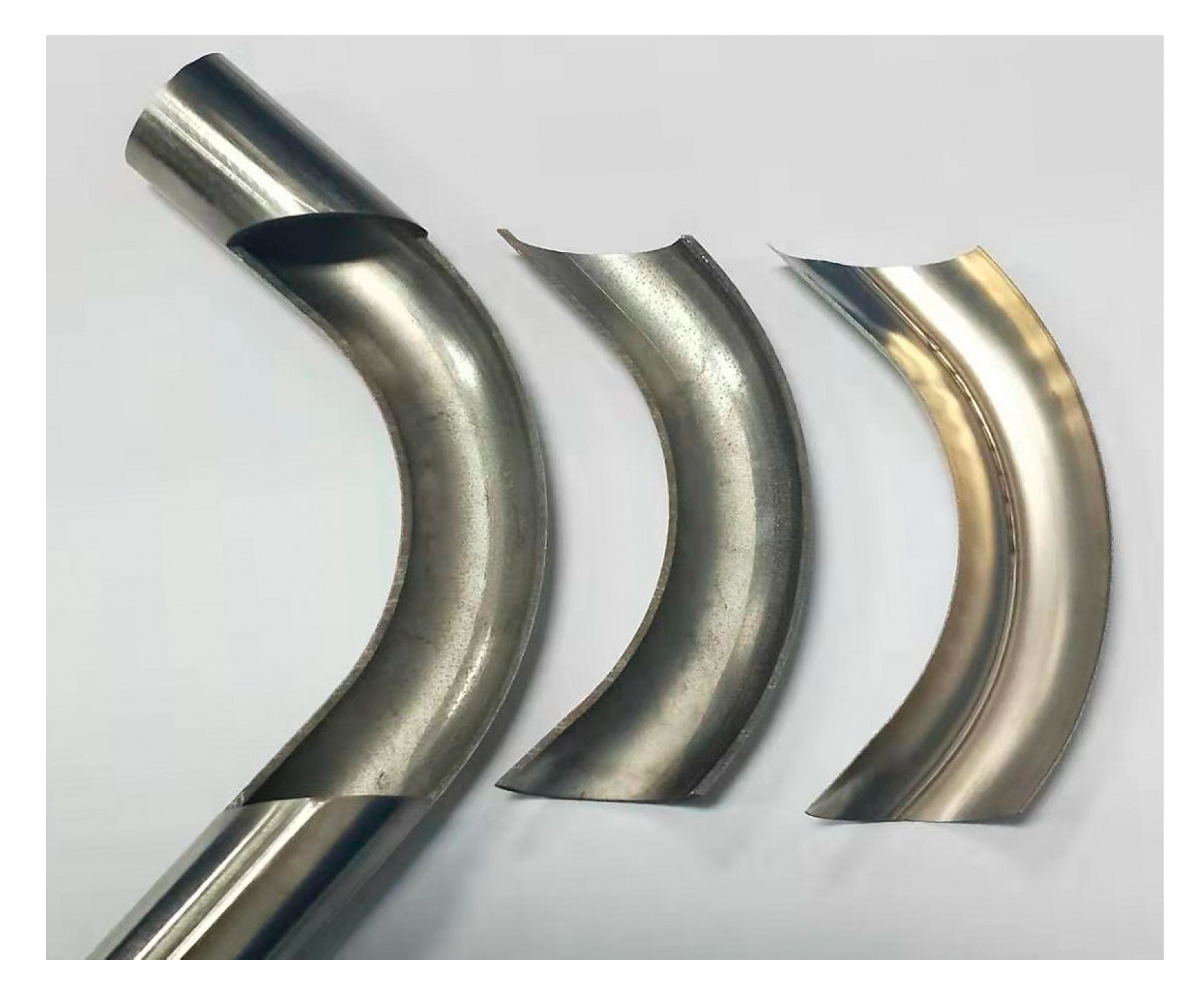
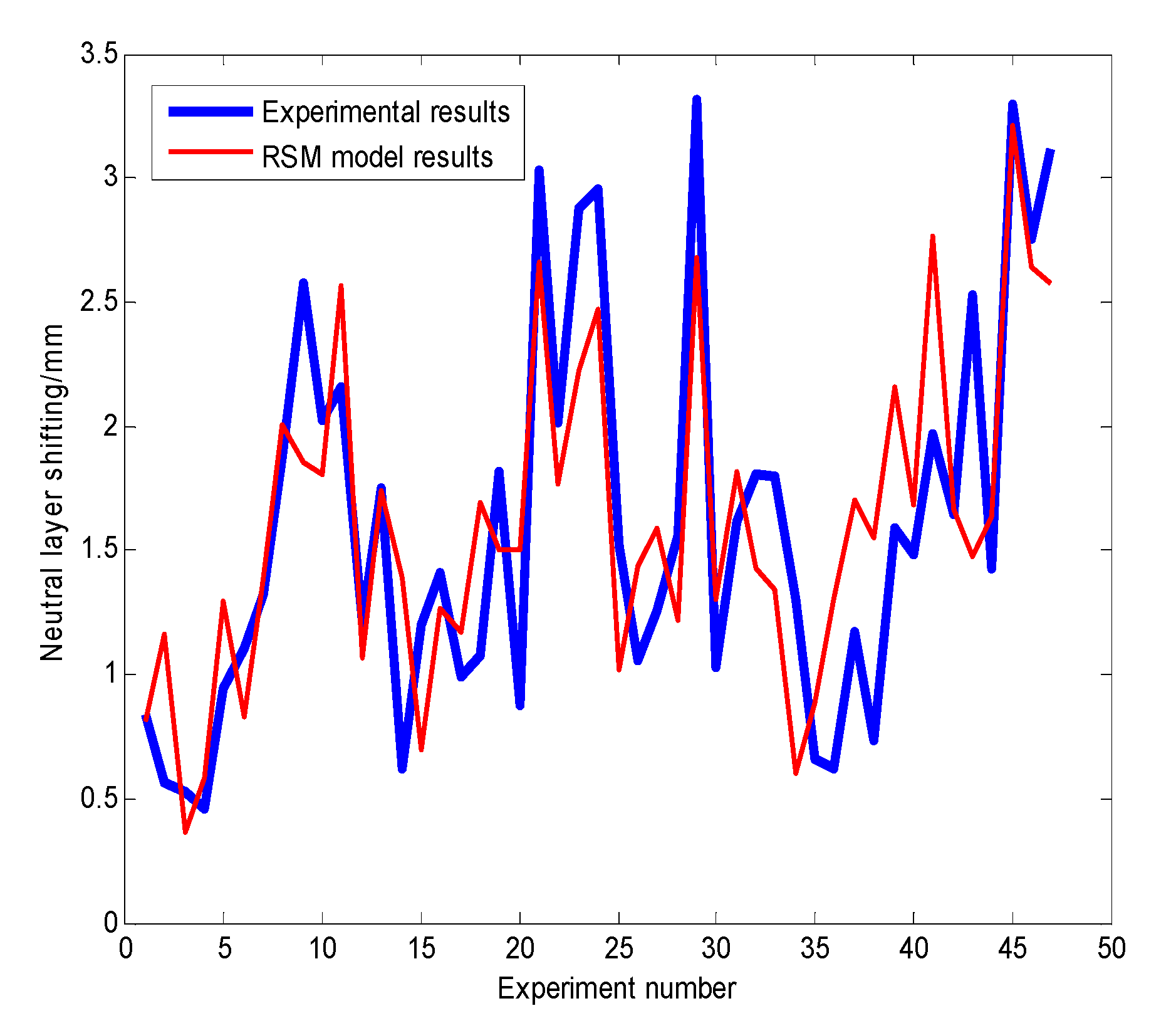
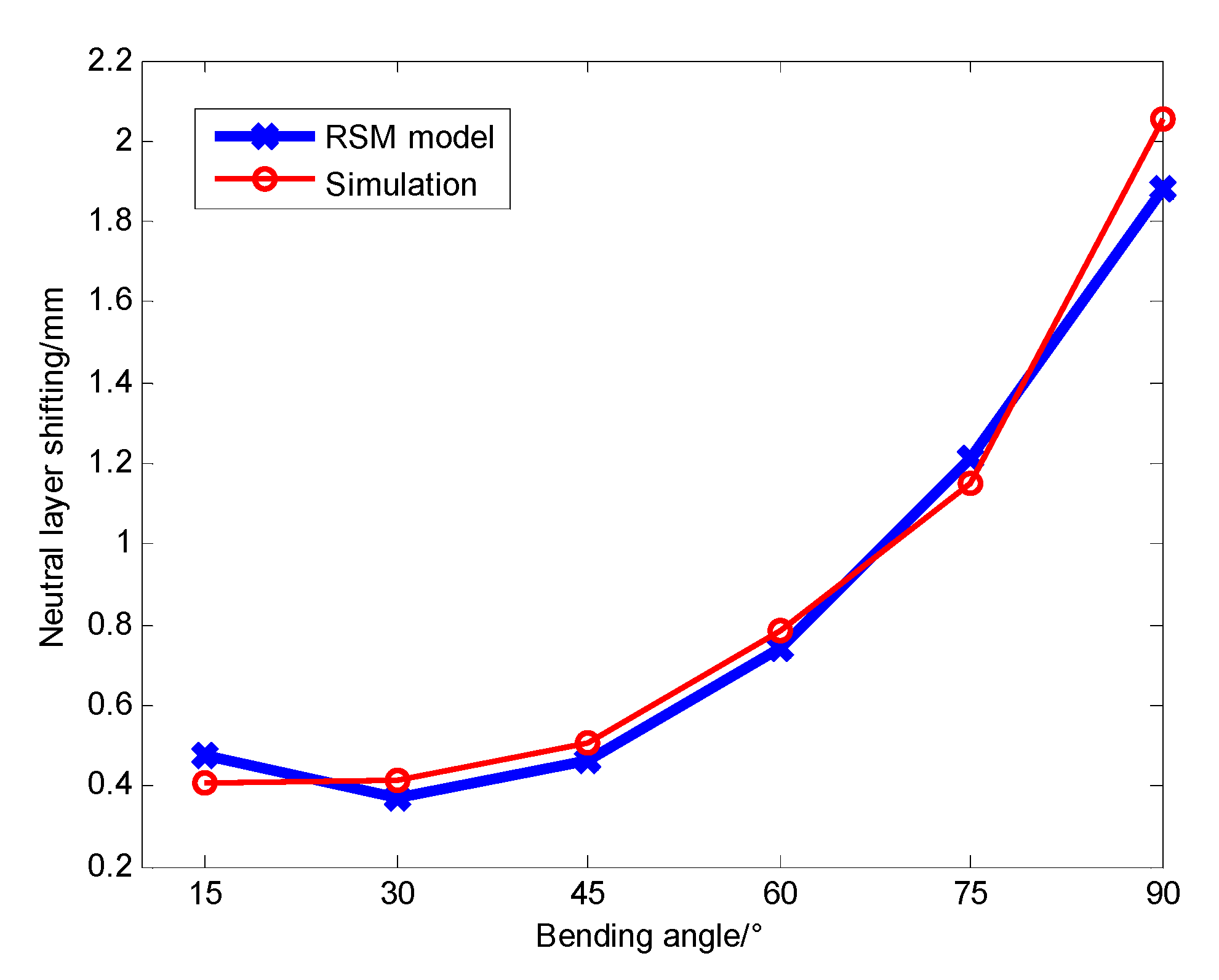
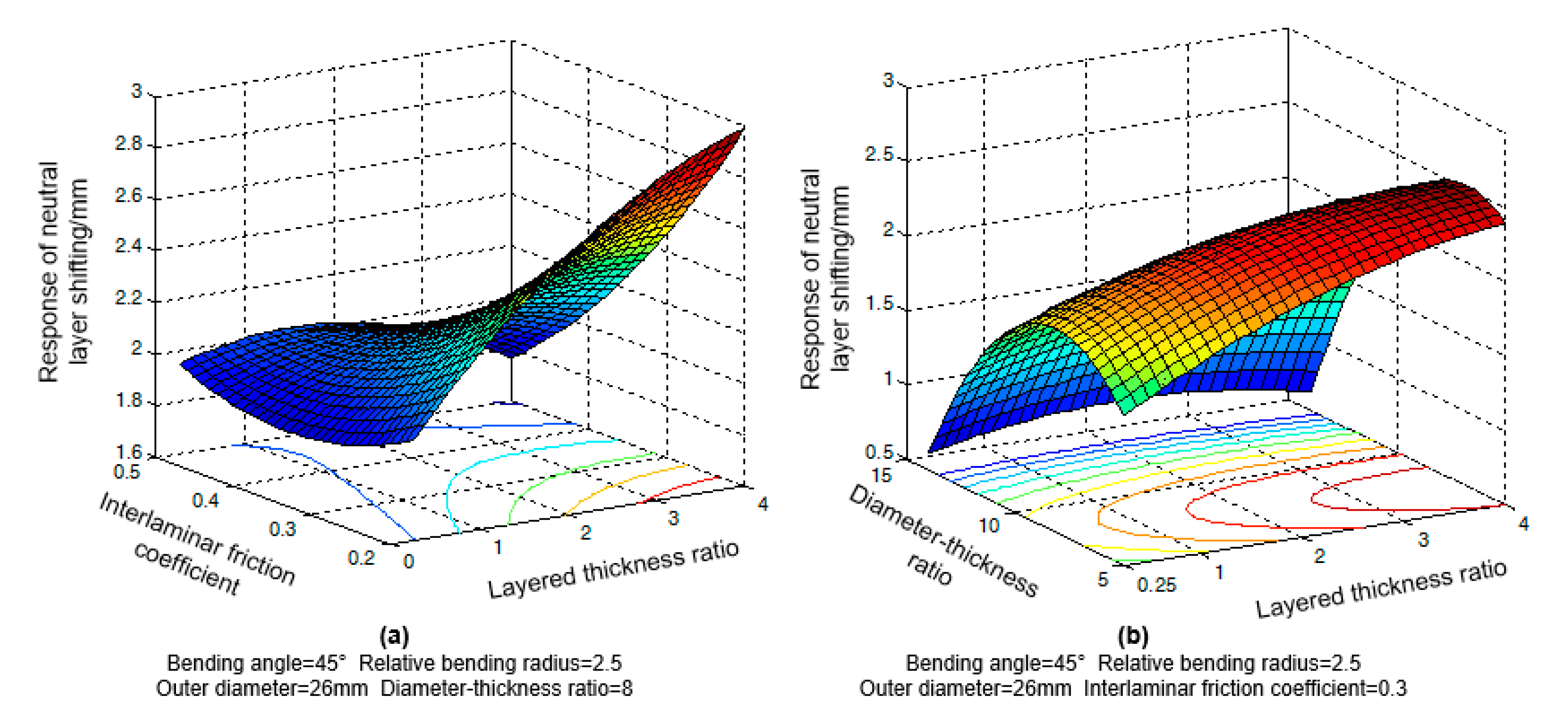
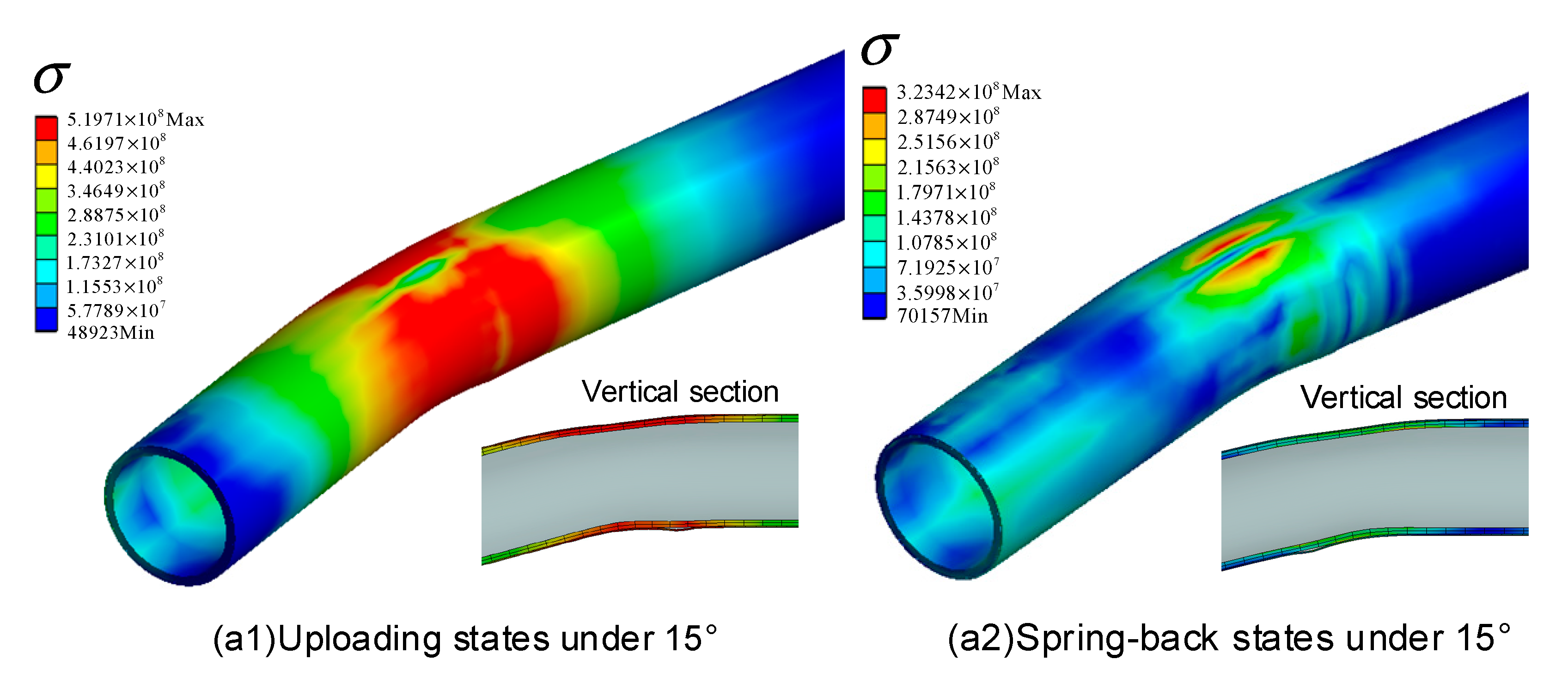
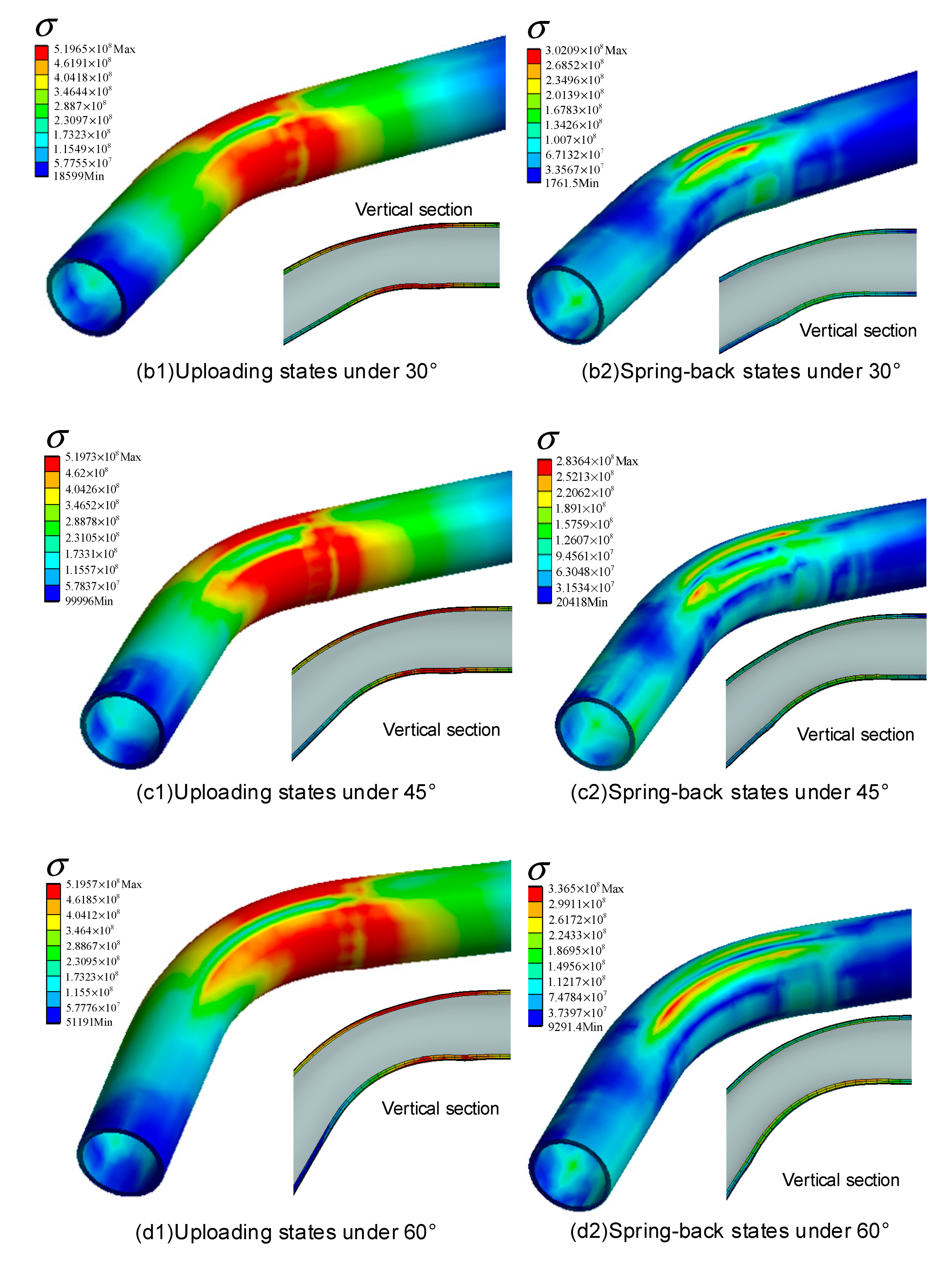
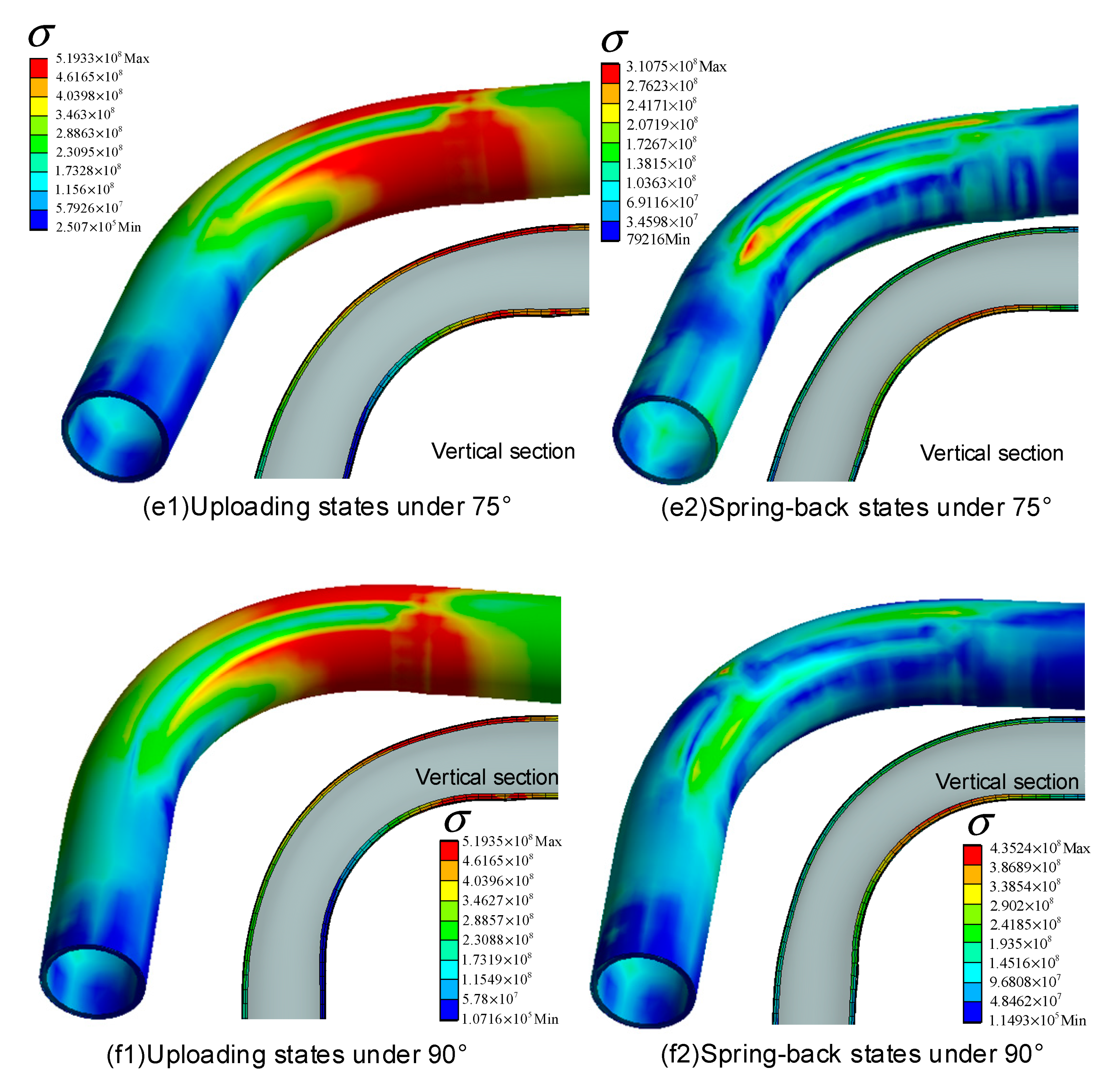
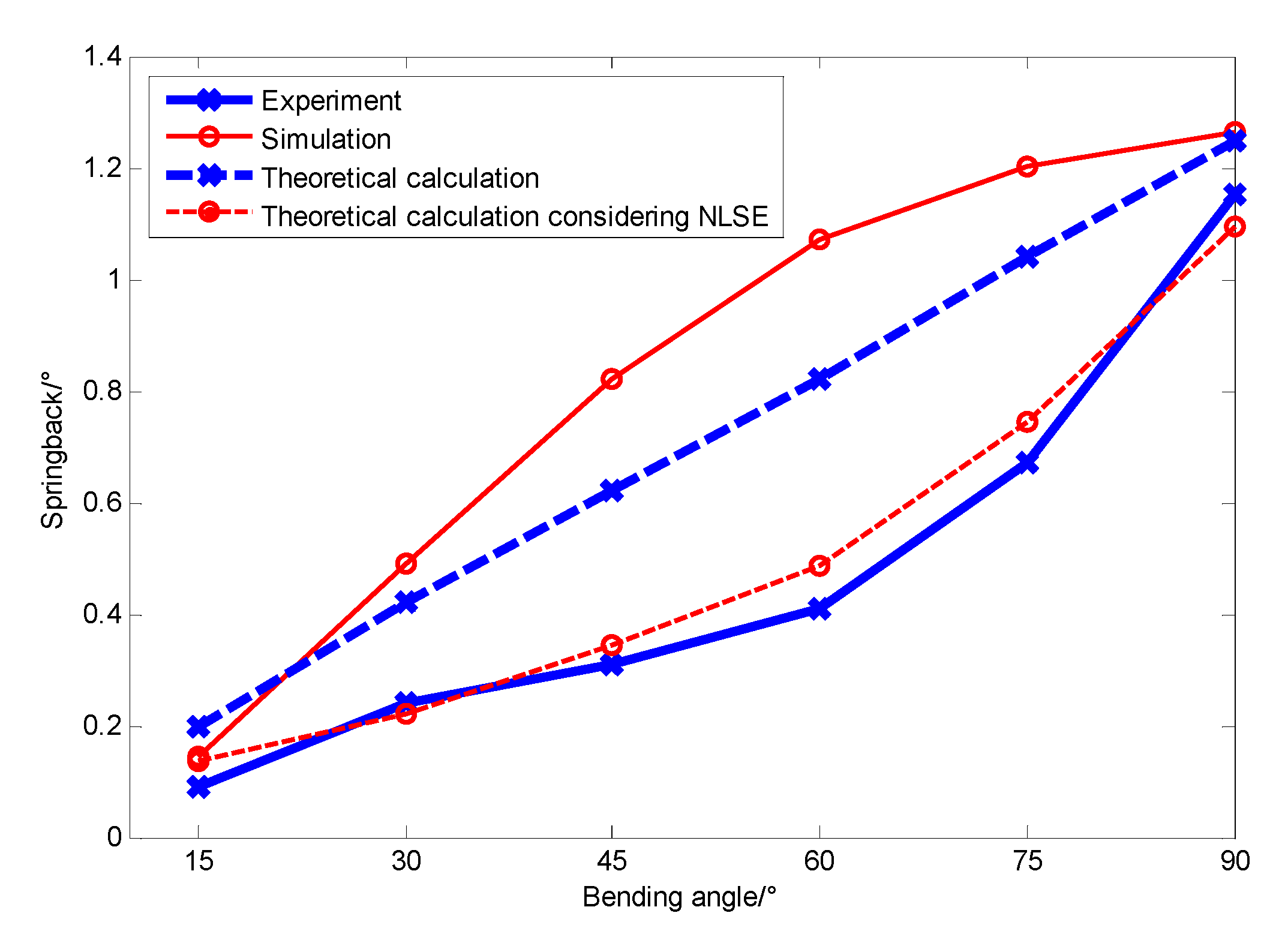
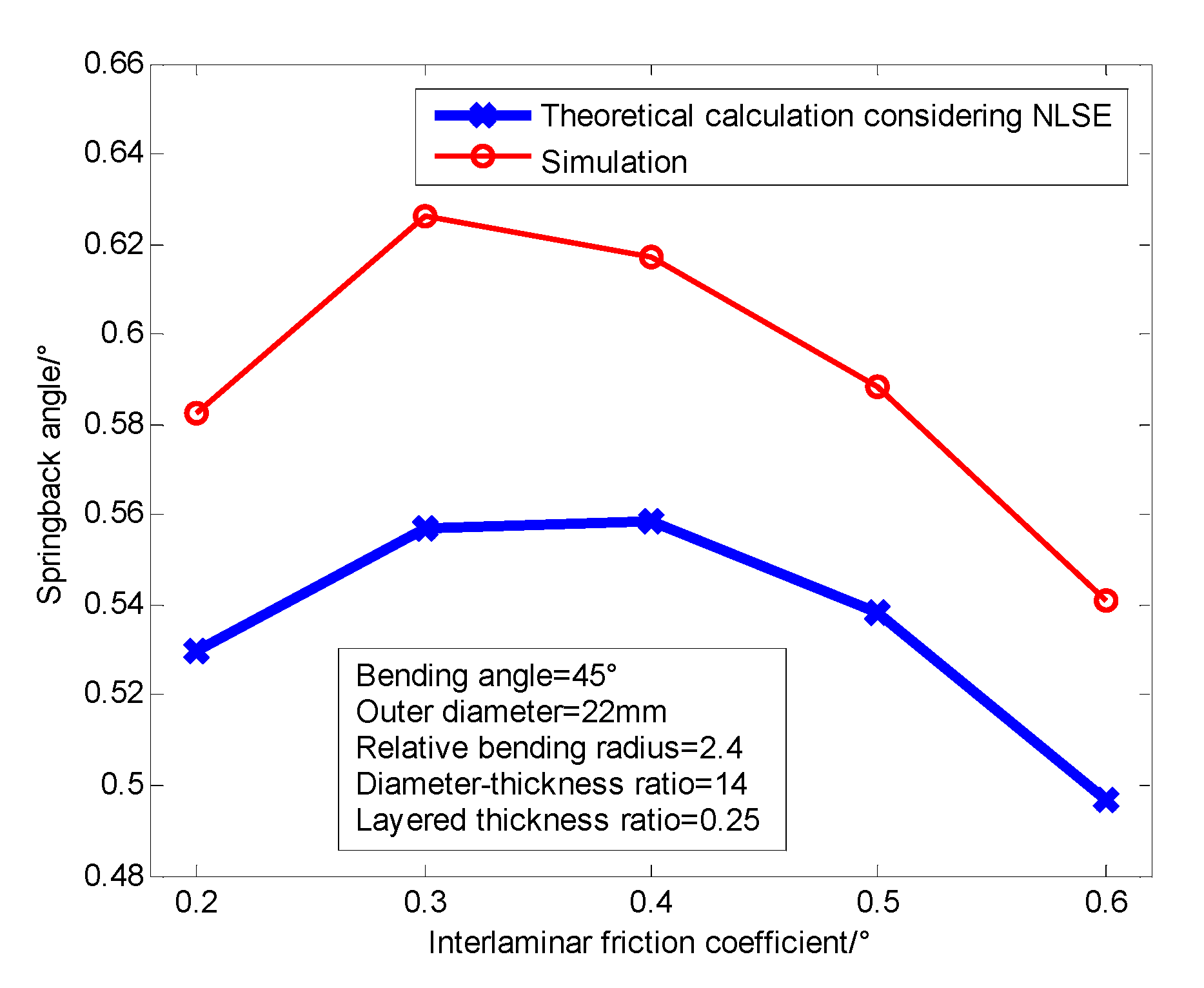
| Physical Meaning | Symbolic Description |
|---|---|
| Location of PathA | |
| Location of PathB | |
| Tangential strain of the element node on PathA | |
| Tangential strain of the element node on PathB |
| Factors Level | A | B | C | D | E | F |
|---|---|---|---|---|---|---|
| Bending Angle/° | Outer Diameter/mm | Relative Bending Radius | Diameter-Thickness Ratio | Layered Thickness Ratio | Interlaminar Friction Coefficient | |
| 1 | 30 | 14 | 1.5 | 4 | 0.25 | 0.2 |
| 2 | 45 | 20 | 2.0 | 6 | 0.5 | 0.3 |
| 3 | 60 | 26 | 2.5 | 8 | 1 | 0.4 |
| 4 | 75 | 32 | 3.0 | 10 | 2 | 0.5 |
| 5 | 90 | 38 | 3.5 | 12 | 4 | 0.6 |
| 6 | 44 | 14 |
| No. | Level Combinations | Experimental Conditions | Results/mm | |||||
|---|---|---|---|---|---|---|---|---|
| Bending Angle/° | Outer Diameter/mm | Relative Bending Radius | Diameter-Thickness Ratio | Layered Thickness Ratio | Interlaminar Friction Coefficient | |||
| 1 | A1B1C1D1E1F1 | 30 | 14 | 1.5 | 4 | 0.25 | 0.2 | 0.8351 |
| 2 | A1B1C2D1E4F4 | 30 | 14 | 2 | 4 | 2 | 0.5 | 0.5649 |
| 3 | A1B1C4D5E1F2 | 30 | 14 | 3 | 12 | 0.25 | 0.3 | 0.5253 |
| 4 | A1B1C5D6E5F4 | 30 | 14 | 3.5 | 14 | 4 | 0.5 | 0.4638 |
| 5 | A1B2C1D1E2F1 | 30 | 20 | 1.5 | 4 | 0.5 | 0.2 | 0.9469 |
| 6 | A1B2C2D2E5F5 | 30 | 20 | 2 | 6 | 4 | 0.6 | 1.1016 |
| 7 | A1B3C2D1E1F5 | 30 | 26 | 2 | 4 | 0.25 | 0.6 | 1.3203 |
| 8 | A1B3C3D3E2F2 | 30 | 26 | 2.5 | 8 | 0.5 | 0.3 | 1.8733 |
| 9 | A1B4C1D2E3F2 | 30 | 32 | 1.5 | 6 | 1 | 0.3 | 2.5798 |
| 10 | A1B4C4D4E1F1 | 30 | 32 | 3 | 10 | 0.25 | 0.2 | 2.0248 |
| 11 | A1B5C2D3E2F1 | 30 | 38 | 2 | 8 | 0.5 | 0.2 | 2.1547 |
| 12 | A1B5C5D5E3F3 | 30 | 38 | 3.5 | 12 | 1 | 0.4 | 1.2119 |
| 13 | A1B6C1D6E2F2 | 30 | 44 | 1.5 | 14 | 0.5 | 0.3 | 1.7542 |
| 14 | A1B6C3D4E4F3 | 30 | 44 | 2.5 | 10 | 2 | 0.4 | 0.6235 |
| 15 | A2B1C1D2E1F3 | 45 | 14 | 1.5 | 6 | 0.25 | 0.4 | 1.1992 |
| 16 | A2B1C2D1E4F4 | 45 | 14 | 2 | 14 | 0.25 | 0.3 | (-) |
| 17 | A2B1C3D1E3F1 | 45 | 14 | 2.5 | 4 | 1 | 0.2 | 1.4084 |
| 18 | A2B1C5D1E2F1 | 45 | 14 | 3.5 | 4 | 0.5 | 0.2 | 0.9895 |
| 19 | A2B2C2D3E3F2 | 45 | 20 | 2 | 8 | 1 | 0.3 | 1.0794 |
| 20 | A2B2C4D1E2F3 | 45 | 20 | 3 | 4 | 0.5 | 0.4 | 1.8154 |
| 21 | A2B3C1D4E2F4 | 45 | 26 | 1.5 | 10 | 0.5 | 0.5 | 0.873 |
| 22 | A2B3C5D2E4F2 | 45 | 26 | 3.5 | 6 | 2 | 0.3 | 3.0349 |
| 23 | A2B4C1D3E1F4 | 45 | 32 | 1.5 | 8 | 0.25 | 0.5 | 2.0175 |
| 24 | A2B4C4D4E1F1 | 45 | 32 | 2 | 12 | 2 | 0.2 | 2.8747 |
| 25 | A2B5C2D4E5F1 | 45 | 38 | 2 | 10 | 4 | 0.2 | 2.9577 |
| 26 | A2B5C3D6E1F5 | 45 | 38 | 2.5 | 14 | 0.25 | 0.6 | 1.5186 |
| 27 | A2B6C1D5E2F5 | 45 | 44 | 1.5 | 12 | 0.5 | 0.6 | 1.0534 |
| 28 | A2B6C4D1E4F2 | 45 | 44 | 3 | 4 | 4 | 0.3 | 1.2545 |
| 29 | A3B1C3D2E2F1 | 60 | 14 | 2.5 | 6 | 0.5 | 0.2 | 1.4648 |
| 30 | A3B1C4D3E4F5 | 60 | 14 | 3 | 8 | 2 | 0.6 | 3.2163 |
| 31 | A3B2C5D4E1F2 | 60 | 20 | 3.5 | 10 | 0.25 | 0.3 | 0.9247 |
| 32 | A3B3C1D5E5F1 | 60 | 26 | 1.5 | 12 | 4 | 0.2 | 1.5218 |
| 33 | A3B4C2D6E2F3 | 60 | 32 | 2 | 14 | 0.5 | 0.4 | 1.7113 |
| 34 | A3B5C1D1E1F2 | 60 | 38 | 1.5 | 4 | 0.25 | 0.3 | 1.6992 |
| 35 | A3B6C2D1E3F4 | 60 | 44 | 2 | 4 | 1 | 0.5 | 1.2065 |
| 36 | A4B1C1D3E5F2 | 75 | 14 | 1.5 | 8 | 4 | 0.4 | 0.6551 |
| 37 | A4B1C2D4E2F2 | 75 | 14 | 2 | 10 | 0.5 | 0.3 | 0.6231 |
| 38 | A4B2C3D5E1F4 | 75 | 20 | 2.5 | 12 | 0.25 | 0.5 | 1.1679 |
| 39 | A4B3C4D6E3F1 | 75 | 26 | 3 | 14 | 1 | 0.2 | 0.7305 |
| 40 | A4B4C5D1E2F5 | 75 | 32 | 3.5 | 4 | 0.5 | 0.6 | 1.5894 |
| 41 | A4B5C1D1E4F2 | 75 | 38 | 1.5 | 4 | 2 | 0.3 | 1.4846 |
| 42 | A4B6C2D2E1F1 | 75 | 44 | 2 | 6 | 0.25 | 0.2 | 1.9647 |
| 43 | A5B1C1D4E3F5 | 90 | 14 | 1.5 | 10 | 1 | 0.6 | 1.6504 |
| 44 | A5B1C2D5E2F2 | 90 | 14 | 2 | 12 | 0.5 | 0.3 | 2.5315 |
| 45 | A5B2C1D5E1F4 | 90 | 20 | 1.5 | 14 | 2 | 0.2 | (-) |
| 46 | A5B3C2D1E1F3 | 90 | 26 | 2 | 4 | 0.25 | 0.4 | 1.4252 |
| 47 | A5B4C3D1E5F2 | 90 | 32 | 2.5 | 4 | 4 | 0.3 | 3.2949 |
| 48 | A5B5C4D2E2F4 | 90 | 38 | 3 | 6 | 0.5 | 0.5 | 2.7536 |
| 49 | A5B6C5D3E1F1 | 90 | 44 | 3.5 | 8 | 0.25 | 0.2 | 3.1178 |
| Selected materials and relevant parameters | Outer layer | Elastic modulus | Strength coefficient | Hardening index | Yield strength |
| Stainless steel 202 | 203 | 343 | 0.5 | 275 | |
| Inner layer | Elastic modulus | Strength coefficient | Hardening index | Yield strength | |
| Q235 | 200 | 947 | 0.3 | 345 | |
| Specifications | Outer radius | Wall thickness of outer layer | Wall thickness of inner layer | Bending radius | |
| 11 | 0.3 | 1.2 | 53 | ||
| Tube Number | Bending Section Number | Theoretical Bending Angle/° | Empirical Bending Angle/° | Spring-back Angle/° |
|---|---|---|---|---|
| T1 | 1 | 90 | 88.6738 | 1.3262 |
| 2 | 75 | 74.2861 | 0.7138 | |
| 3 | 60 | 59.6963 | 0.3037 | |
| 4 | 45 | 44.7153 | 0.2847 | |
| 5 | 30 | 29.8035 | 0.1965 | |
| 6 | 15 | 14.9187 | 0.0813 | |
| T2 | 7 | 90 | 89.0270 | 0.9730 |
| 8 | 75 | 74.3825 | 0.6175 | |
| 9 | 60 | 59.5063 | 0.4937 | |
| 10 | 45 | 44.6647 | 0.3353 | |
| 11 | 30 | 29.7233 | 0.2767 | |
| 12 | 15 | 14.9065 | 0.0935 |
© 2020 by the authors. Licensee MDPI, Basel, Switzerland. This article is an open access article distributed under the terms and conditions of the Creative Commons Attribution (CC BY) license (http://creativecommons.org/licenses/by/4.0/).
Share and Cite
Zhang, S.; Fu, M.; Wang, Z.; Lin, Y.; He, C. Spring-Back Prediction of the Bi-Layered Metallic Tube under CNC Bending Considering Neutral Layer Shifting Extraction. Appl. Sci. 2020, 10, 4978. https://doi.org/10.3390/app10144978
Zhang S, Fu M, Wang Z, Lin Y, He C. Spring-Back Prediction of the Bi-Layered Metallic Tube under CNC Bending Considering Neutral Layer Shifting Extraction. Applied Sciences. 2020; 10(14):4978. https://doi.org/10.3390/app10144978
Chicago/Turabian StyleZhang, Shuyou, Mengyu Fu, Zili Wang, Yaochen Lin, and Ci He. 2020. "Spring-Back Prediction of the Bi-Layered Metallic Tube under CNC Bending Considering Neutral Layer Shifting Extraction" Applied Sciences 10, no. 14: 4978. https://doi.org/10.3390/app10144978
APA StyleZhang, S., Fu, M., Wang, Z., Lin, Y., & He, C. (2020). Spring-Back Prediction of the Bi-Layered Metallic Tube under CNC Bending Considering Neutral Layer Shifting Extraction. Applied Sciences, 10(14), 4978. https://doi.org/10.3390/app10144978





